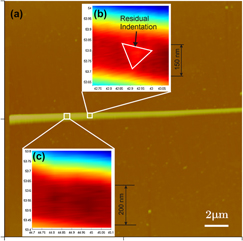Article contents
Measurement of mechanical properties of alkaline-earth metal hexaboride one-dimensional nanostructures by nanoindentation
Published online by Cambridge University Press: 27 March 2012
Abstract

The divalent alkaline-earth metal hexaboride MB6 (M = Ca, Sr, Ba) one-dimensional (1D) nanostructures are promising n-type thermoelectric materials for high temperature power generation. Understanding fundamental physical and mechanical properties of these new nanostructures is critical for their future applications. Current work focuses on reliable study of mechanical properties of MB6 1D nanostructures by nanoindentation. Factors affecting the measured nanostructure-on-substrate system modulus, such as the stiffness of a supporting substrate, the width and cross section of a nanostructure, the interaction between a nanostructure and a substrate, were systematically studied by both experimental investigation and numerical simulation. The intrinsic modulus of a nanostructure, extracted from the measured system modulus, was determined between two bounds set by the receding contact and the perfect bond interaction between a nanostructure and a substrate, respectively. The extracted modulus increases as the width-to-thickness ratio of a nanostructure increases from 1 to 2.
- Type
- Articles
- Information
- Copyright
- Copyright © Materials Research Society 2012
References
REFERENCES
- 4
- Cited by


